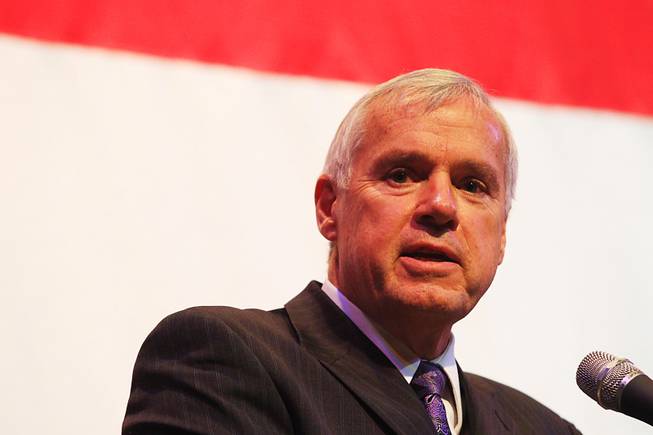
Chancellor Dan Klaich speaks during a town hall style meeting about education Tuesday, Nov. 29, 2011 on the CSN Cheyenne campus.
Friday, March 2, 2012 | 2:41 p.m.
Related story
The framework for a new higher education funding formula is nearly complete after months of feedback from college presidents, faculty and students, Nevada's higher education chancellor said Friday.
"We're kind of in the red zone," Dan Klaich, chancellor of the Nevada System of Higher Education, said in an update to the Board of Regents. "We're about to be able to put this portion of this task to bed."
In January, Klaich unveiled a new funding model, which seeks to create a more equitable way to allocate state funds for higher education by shifting the focus from enrollment figures to performance – how many students each institution graduates.
The current formula – used by the Legislature to fund Nevada’s seven public universities and colleges – has been long criticized for being too complicated, unfair and increasingly different to understand, Klaich said.
Currently, student tuition and fees are collected from each institution and pooled into the state's general fund, a practice that is frowned upon by critics who believe it turns students into taxpayers and argue tuition dollars should remain on campus. The Legislature then allocates funding from the pool based on a school's enrollment, course offerings, cost of maintenance and whether it is urban or rural.
The proposed new formula allows institutions to keep tuition dollars and registration fees they collect. Those funds then would be supplemented with about $370 million in state funding.
The state would use an "instructional matrix" to distribute general fund dollars for higher education, Klaich said.
Under the matrix, each college-level course has been categorized into 11 disciplines: Liberal arts, basic skills, business, education, services, visual/performing arts, technical trades, sciences, law, engineering and health.
Each discipline would be weighted based on how much it costs the state to offer the course. Resource-intensive degrees in science, engineering and medical fields would be funded more than liberal arts programs. Doctoral programs would be funded more than undergraduate degrees.
The recommended weights were modeled after studies of funding formulas used in Texas, Ohio, Illinois and Florida, Klaich said. Courses at all institutions – from urban research universities to rural community colleges – will use the same matrix, he said.
"I'm not making a comment on the value of these courses but the cost of delivery," Klaich said, adding that final cost figures for courses would be announced in March.
Higher education leaders still are working on an adequate way to reward each institution's performance and "success" – defined by the number of students completing degrees. The more degree completions a college has, the more additional funding would be allocated, Klaich said.
The new model's shift in emphasis from enrollment to degrees completed has raised concerns among Nevada's community colleges, which serve large student populations that generally have a higher dropout rate than research universities. The average community college student also takes more time to complete a degree program, and many community college students require remediation courses not funded under the new formula.
Regent Rick Trachok questioned the new emphasis on degree completion, asking Klaich whether students who found personal educational fulfillment from courses would be considered "successes" under the formula. Community colleges serve a unique student population – such as retirees seeking continuing education and vocational students looking to forward their careers – that do not necessarily seek a full-fledged degree or certification, he said.
In a constrained budget period, state and national education leaders are focusing on degree "completers" who are more likely to find jobs, Klaich said.
"We can't take into account personal successes and desires," he said. "We've got an obligation (to taxpayers) to get students in and out and make sure they are successfully graduating."
Klaich suggested that local municipalities give additional support to community colleges, a hard sell for cash-strapped Las Vegas Valley cities and Clark County. No large state has such as system to fund community colleges, UNLV President Neal Smatresk said.
The new funding formula is expected to be complete by the 2013 legislative session and would be instituted in phases over several years, Klaich said. Regents seemed to largely support the direction of the new funding blueprint despite lingering questions from community colleges.
"I understand that community colleges may be negatively affected by this… (but) we have to give taxpayers a good deal," said Regent Robert Blakely, addressing Klaich. "I'm with you on this."

Join the Discussion:
Check this out for a full explanation of our conversion to the LiveFyre commenting system and instructions on how to sign up for an account.
Full comments policy